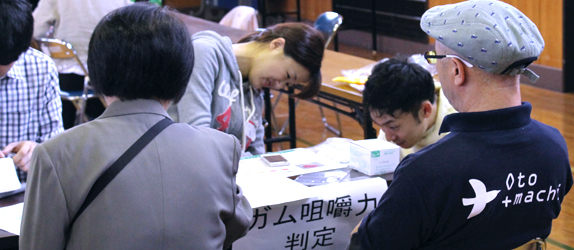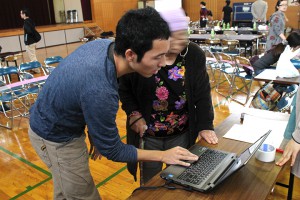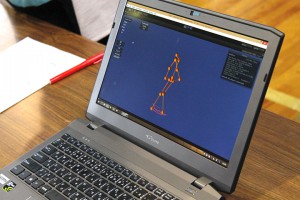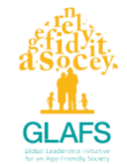2014年10月13日
10月13日「コミュニティ活動のファシリテーション」グループ (1)
「コミュニティ活動のファシリテーション」グループ(1)共同研究の目的:「複数のコミュニティ活動への支援とフィードバックから、より良いコミュニティ形成のツールを開発する」 |
|
 |
|
| 10月13日に開催された柏市豊四季台団地に住む一人暮らし高齢者を対象とした“懇談と昼食会”に〈コミュニティ活動のファシリテーション〉グループがブース「脳とからだチャレンジ」を出した。ブースに集まってきたのは健康に関心のある高齢者の方々。その中から約40名が自分の健康状態を数値などでセルフチェック。日頃の生活状況を振り返った。 参加にあたっては、保健師の資格をもつコース生が、その日の体調を聞き取り、血圧を測定するなどして、健康状態を確認した。その後、咀嚼力判定ガム、体組成計による測定、ロコモティブシンドロームをスクリーニングする「立ち上がりテスト」のほか、情報理工チームが開発した「認知記憶トレーニング」(三浦特任助教制作ソフト)や3Dモデルによって歩行姿勢が可視化できる装置「歩行姿勢チェック」などを試してもらい、ひとりひとりの結果についてきめ細かくアドバイス。参加者はどのコーナーも楽しみながらチャレンジしていて、行列ができるほどの大盛況だった。 「歩行姿勢チェック」を開発したコース生の小嶋泰平さん(情報理工学系研究科 知能機械情報学専攻)は「最終的に20人くらいの方に試していただき、高齢者の歩行特徴を数多く確認できました。歩行姿勢を改善するためにこちらからフィードバックをしたのですが、それも概ね好意的に受け止められたようで、参加者の前向きな意識を感じさせられました。これをきっかけに、健康づくりに興味がある高齢者の方々がコミュニティ活動に参加していけるような取り組みを考え、実行していきたいと思います」と言う。 今後グループは地域の実態把握のためのワークショップを実施したり、「移動!暮らし保健室」や「くるるセミナー」などと連携しながらコミュニティ形成のツールを開発研究していく予定だ。 | |
 |
受付では保健師資格を持ったコース生(左端)たちが健康状態のチェックを行い、「脳とからだチャレンジ」に参加できるかどうかを診断した。隣では、咀嚼力判定ガムを噛んでもらい、その色の変化を見て咀嚼力をチェックした。 |
 |
体組成計による測定。測定値を見てアドバイスするのは保健師の資格を持つコース生(左端)たち。 |
 |
足腰の力強さとバランス能力を見る「立ち上がりテスト」。ここでも理学療法士の資格を持ったコース生が説明を担当した。 |
 |
「認知記憶トレーニング」に真剣に取り組む参加者。25のマス目に仕切られた画面に現れる紺色のブロックのパターンを5秒間で覚え、5秒休んだ後に入力・再現する。回を重ねるごとにブロックの数が増えていく。3回間違えたところで終了。13回続けてチャレンジした参加者もいた。 |
| 人間の姿勢を計測できる特殊なカメラを利用して歩行姿勢をデータ化し,コンピュータ上で処理・分析を行って3Dモデルによる可視化を行う「歩行姿勢チェック」のコーナー。実際に歩いてもらった後、画像(写真右)を見てもらいながら、歩行姿勢について説明した。 | |
 |
 |
| 2015.2.7(2)の模様はこちらからご覧ください | |
 |
|
Facilitation Group for Community Activities (1)Collaborative research objective: to develop tools for creating a better community formation by supporting various community activities and providing feedback |
|
 |
|
| On October 13th, the Community Activities Facilitation Group set up a booth called “Brain and Body Challenge” at a social gathering and luncheon event (commonly called the “workshop for 200 people”) which was intended for elderly people living alone in the Toyoshikidai housing complex. Elderly people interested in their health gathered at the booth. About 40 people tried a self-check and reflected back on their daily living conditions. A GLAFS student who is a qualified registered nurse talked with participants, checked blood pressure measurements, and assessed health conditions. Participants also conducted bite force tests with a special gum, took measurements with a body composition analyzer, completed the “stand-up” test to screen for locomotive syndrome, tried cognitive memory training via a system developed by the Graduate school of Information Science and Technology (Software designed by Project Assistant Professor Miura), and did a walking posture check using a 3D visualization system. The GLAFS student advised each participant carefully and each corner was full of people enjoying the experience. Taihei Kojima from the Department of Mechano-Informatics at the Graduate School of Information Science and Technology, who developed the walking posture check technology said, “about 20 people were tested and I was able to examine some key characteristics of the walking posture of the elderly. I gave feedback to each participant to help them improve their walking posture and I was happy that most participants were positive about what I said. I felt their positivity. I would like to implement the framework to allow elderly individuals interested in their own health promotion to actively participate in community activities.” The group is planning to conduct workshops to develop the tools in cooperation with The “Let’s Move! Healthcare Room” and the “Kururu Seminar.” |
|
 |
At reception, a GLAFS student who is a qualified public health nurse (far left) conducted health check-ups determined whether individuals were able to participate in the “Brain and Body Challenge.” Next, staff checked participants’ bite force by asking examinees to chew gum and checking to see how colors changed in the gum |
 |
Evaluation via the Body Composition Analyzer “InBody” GLAFS students who are qualified registered nurses gave advice by looking at the measurement values. |
 |
The stand-up test was conducted to analyze the strength of legs, backs, and balance capacity. GLAFS PT students gave explanations of the results. |
 |
Participants tried a cognitive memory training exercise in which users must memorize a 25 square color block pattern displayed on a screen in five seconds. After a five second pause, users then had to re-create the pattern. Each time a participant successfully completed a trial, the number of blocks increased. If participants made three mistakes, the game ended. There was a super participant who completed 13 consecutive trials. |
| There was a corner where participants could check their walking posture. A special camera which can measure human posture was used to convert walking postures into data to be executed and analyzed on PC. The data was then re-created as a three-dimensional visualization. The staff explained the “walking posture” by letting the participant walk and look at the image on the screen (right photo). | |
 |
 |
| Please see here:Group considering “Facilitation of community activities” February 2, 2015(2) | |
 |
|

